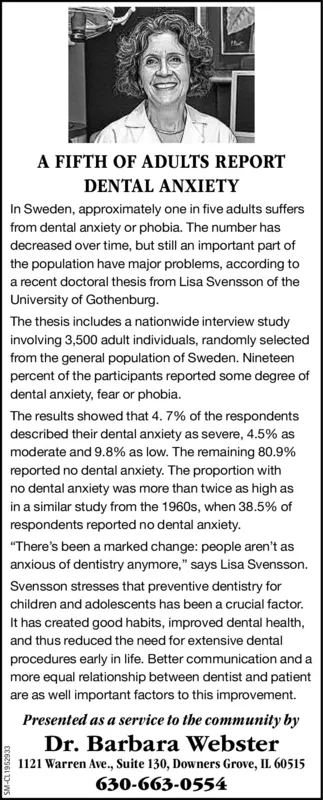Advertisement

-
Published Date
February 10, 2022This ad was originally published on this date and may contain an offer that is no longer valid. To learn more about this business and its most recent offers, click here.
Ad Text
A FIFTH OF ADULTS REPORT DENTAL ANXIETY In Sweden, approximately one in five adults suffers from dental anxiety or phobia. The number has decreased over time, but still an important part of the population have major problems, according to a recent doctoral thesis from Lisa Svensson of the University of Gothenburg. The thesis includes a nationwide interview study involving 3,500 adult individuals, randomly selected from the general population of Sweden. Nineteen percent of the participants reported some degree of dental anxiety, fear or phobia. The results showed that 4. 7% of the respondents described their dental anxiety as severe, 4.5% as moderate and 9.8% as low. The remaining 80.9% reported no dental anxiety. The proportion with no dental anxiety was more than twice as high as in a similar study from the 1960s, when 38.5% of respondents reported no dental anxiety. "There's been a marked change: people aren't as anxious of dentistry anymore," says Lisa Svensson. Svensson stresses that preventive dentistry for children and adolescents has been a crucial factor. It has created good habits, improved dental health, and thus reduced the need for extensive dental procedures early in life. Better communication and a more equal relationship between dentist and patient are as well important factors to this improvement. Presented as a service to the community by Dr. Barbara Webster 1121 Warren Ave., Suite 130, Downers Grove, IL 60515 630-663-0554 A FIFTH OF ADULTS REPORT DENTAL ANXIETY In Sweden, approximately one in five adults suffers from dental anxiety or phobia. The number has decreased over time, but still an important part of the population have major problems, according to a recent doctoral thesis from Lisa Svensson of the University of Gothenburg. The thesis includes a nationwide interview study involving 3,500 adult individuals, randomly selected from the general population of Sweden. Nineteen percent of the participants reported some degree of dental anxiety, fear or phobia. The results showed that 4. 7% of the respondents described their dental anxiety as severe, 4.5% as moderate and 9.8% as low. The remaining 80.9% reported no dental anxiety. The proportion with no dental anxiety was more than twice as high as in a similar study from the 1960s, when 38.5% of respondents reported no dental anxiety. "There's been a marked change: people aren't as anxious of dentistry anymore," says Lisa Svensson. Svensson stresses that preventive dentistry for children and adolescents has been a crucial factor. It has created good habits, improved dental health, and thus reduced the need for extensive dental procedures early in life. Better communication and a more equal relationship between dentist and patient are as well important factors to this improvement. Presented as a service to the community by Dr. Barbara Webster 1121 Warren Ave., Suite 130, Downers Grove, IL 60515 630-663-0554
